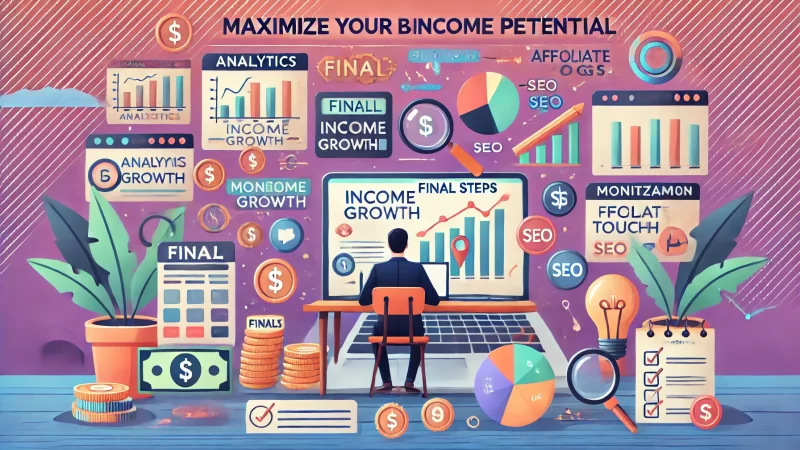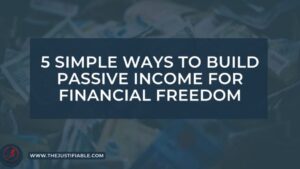Table of Contents
Are you searching for the fastest way to make money blogging? Whether you’re just starting or looking to speed up your earnings, this guide answers your questions and offers proven methods to generate income quickly.
From setting up essential strategies to leveraging various monetization channels, here’s a structured breakdown of how to make money blogging fast.
Essential Steps For Quick Blog Monetization
Starting with essential strategies can fast-track your blog’s ability to generate income. By selecting the right niche, setting up your platform, and using a strategic content approach, you’ll lay the foundation for quick and effective blog monetization.
Choose Profitable Blogging Niches
Choosing a niche with a strong audience demand and monetization potential is key. I suggest identifying topics that align with both your interests and profitability. Research niches with high search traffic and competition levels to gauge potential earnings.
Profitable niches often revolve around solutions to common problems. Health, finance, lifestyle, and personal development niches are typically high in demand. Focusing on a niche you’re passionate about helps create content that resonates with readers, building trust.
For faster results, look into trending subtopics within larger niches. These are usually easier to rank for and provide opportunities to attract targeted traffic. A niche with clear demand allows you to monetize effectively.
Monetization options can vary greatly by niche, so choose one that allows flexibility. For example, in a finance niche, you could explore affiliate marketing, sponsored content, and ad placements, maximizing revenue streams.
Set Up A Money-Making Blog Platform
Setting up a reliable platform is crucial for effective monetization. I recommend using WordPress, as it offers flexibility with plugins designed for monetizing blogs. A well-structured, fast-loading blog retains visitors, which positively impacts SEO.
Ensure your blog design is clean, user-friendly, and mobile-responsive. This enhances user experience, encouraging readers to stay longer. Simple, easy navigation keeps readers engaged and is essential for successful monetization strategies.
Hosting services also play a role in monetization. Invest in quality hosting to ensure your blog is consistently available and fast. Slow or unreliable hosting can reduce your audience, limiting monetization potential.
For optimal income opportunities, explore plugins for SEO, affiliate marketing, and social sharing. These tools can simplify management and maximize your blog’s revenue potential with minimal effort.
Optimize Blog Content For SEO Success
Content optimization is central to monetizing a blog quickly. I suggest using SEO-friendly keywords within headings, body text, and image descriptions. This helps search engines understand your blog’s relevance to user queries, boosting organic traffic.
On-page SEO also involves using meta titles and descriptions effectively. Engaging titles attract clicks, while optimized descriptions provide context. These elements play a big role in attracting readers, which supports faster blog growth and monetization.
Internal linking to relevant posts enhances user engagement and boosts page rankings. This helps guide readers through related content, improving time spent on the site. A well-optimized blog is more visible, which leads to quicker income generation.
Creating SEO-optimized content keeps readers coming back. High-quality, relevant posts encourage visitors to engage with ads, affiliate links, and other monetization elements, driving up revenue opportunities.
Develop A Consistent Content Strategy
Consistency in posting helps establish authority and retains readers. I suggest creating a content calendar to maintain a steady flow of posts. Frequent updates signal to readers and search engines that your blog is active and valuable.
Quality is just as important as quantity. Each post should provide genuine value, addressing readers’ needs or questions. Valuable content encourages more interaction, helping you attract repeat visitors and increase monetization success.
Incorporate a mix of post types like guides, listicles, and opinion pieces. This variation keeps content fresh and engaging for readers. Readers enjoy diverse content, and it supports multiple monetization methods.
Consistency also involves following trends in your niche. Staying updated with popular topics enhances relevance, attracting new visitors and increasing opportunities for income through ads and affiliate links.
Use Keyword Research For High-Traffic Topics
Keyword research reveals high-demand topics that attract readers. I recommend using tools like SEMrush or SEOPowersuite to find keywords with strong search volumes but manageable competition. This approach speeds up ranking and increases visibility.
Long-tail keywords are particularly effective for new blogs. These specific terms often face less competition, making it easier for your blog to appear on search results, bringing in targeted traffic that’s more likely to engage with monetization efforts.
For successful keyword usage, integrate primary keywords naturally into headings and body text. This helps search engines recognize your blog’s focus, driving relevant traffic. Targeted traffic often leads to quicker conversions and earnings.
Exploring related keywords also helps build topical authority. By covering various aspects of a main topic, your blog becomes a go-to resource, attracting readers and improving monetization through multiple revenue channels.
Popular Monetization Strategies For Bloggers

Exploring various monetization strategies can increase your blog’s revenue. Affiliate marketing, display ads, sponsored posts, and selling digital products all offer ways to generate income. By diversifying, you’ll maximize earnings and minimize dependency on one source.
Earn Through Affiliate Marketing Programs
Affiliate marketing allows bloggers to earn by promoting products. Choose high-quality products that fit your niche, as promoting relevant items increases conversion rates. Affiliates like Flexoffers and ShareASale offer access to numerous reputable products.
Effective affiliate marketing involves creating content that demonstrates the product’s value. Tutorials, reviews, and listicles work well, offering readers insights into the product. High-value content drives engagement, making readers more likely to click and buy.
I suggest focusing on products that you’d recommend. Authenticity builds trust, which increases the likelihood of readers acting on affiliate links. Trustworthy recommendations benefit both your readers and your blog’s earnings.
Affiliate marketing income grows as traffic increases. Keep optimizing posts to reach a broader audience, improving click-through rates and boosting earnings. With a well-planned approach, affiliate income becomes a significant revenue stream.
Make Money With Display Advertising
Display ads are a straightforward way to monetize blog traffic. Platforms like Google AdSense and Adsterra place ads on your blog, paying for clicks or impressions. These platforms automatically serve ads relevant to your readers, enhancing engagement.
To succeed with display ads, it’s important to maintain a balance between content and ads. Too many ads can disrupt user experience, causing visitors to leave. Use ad placements that integrate well into the design for a seamless experience.
Display ads work well with high-traffic blogs. As your readership grows, display ads can yield significant revenue. They provide a passive income stream, allowing you to focus on creating valuable content without extensive management.
Earnings from display ads depend on ad type and placement. Experiment with positions like header, sidebar, or within content to see what performs best. Tracking results helps you optimize placements for maximum revenue.
Sponsored Posts And Partnerships
Sponsored posts offer another lucrative option, where brands pay for content that features their products. Focus on partnerships with brands that align with your blog’s niche, enhancing relevance and trust among your readers.
To create effective sponsored content, I suggest writing in an informative tone, highlighting the brand’s benefits without appearing overly promotional. Readers value authentic opinions, so balance between promotional and informational content.
Long-term partnerships often develop when initial posts perform well. Consistently creating quality sponsored content encourages brands to return, providing a steady income. These partnerships can become a reliable revenue stream as your blog grows.
Negotiating rates is key to maximizing sponsored post income. As your blog’s audience expands, higher rates become justifiable, boosting income potential. Reliable partnerships build both revenue and authority within your niche.
Sell Digital Products On Your Blog
Selling digital products like e-books, templates, or guides can be highly profitable. These products require upfront effort but offer passive income. Focus on creating resources that your audience finds useful, providing value in exchange for a purchase.
Promote digital products naturally within blog content. For example, if your blog is about personal finance, sell budget templates or financial guides. Relevant products resonate with readers, increasing the likelihood of sales.
Using tools like Gumroad or Payhip simplifies product management and transactions. These platforms handle payments and downloads, letting you focus on creating quality content. This makes selling digital products accessible for bloggers at all levels.
Digital products can diversify income streams, reducing reliance on ads or affiliates. As your blog gains popularity, expand your product offerings to meet evolving reader interests, boosting sales and reinforcing your brand authority.
Offer Premium Content Or Membership Access
Premium content and memberships allow you to monetize loyal readers. Create exclusive content, like advanced tutorials or insider tips, to add value for subscribers willing to pay for additional insights.
A membership model establishes a steady income stream. By offering regular updates or exclusive articles, you maintain reader engagement. This model is particularly effective for niche topics where readers seek ongoing expertise.
I suggest using platforms like Patreon or Substack, which simplify subscription management. These platforms let readers subscribe easily, fostering a community and providing a stable revenue source without extensive technical setup.
Engage members with a personal touch, like direct Q&As or personalized advice. This strengthens the community, making memberships feel valuable. Consistent, exclusive content keeps subscribers engaged, making this a dependable income source.
Affiliate Marketing: Fastest Route To Blog Revenue
Affiliate marketing offers a swift path to generating blog income. By promoting relevant products and earning commissions on sales, you can monetize your content effectively. Selecting high-commission programs and strategic link placement will optimize your revenue.
Selecting High-Commission Affiliate Programs
Choosing high-commission programs is essential for maximizing affiliate revenue. I recommend researching platforms that offer competitive commissions in your niche. Look for reputable networks like MyLead or Awin with quality products to enhance trust and conversion rates.
Focus on products your audience genuinely needs. When you align product offerings with your readers’ interests, it feels more natural and relatable. Readers trust honest recommendations, increasing the chances of successful conversions and boosting affiliate income.
I advise exploring direct affiliate partnerships with companies. Often, brands offer higher commissions when working directly with bloggers. This approach also fosters long-term relationships, adding stability to your blog’s income stream.
High-commission programs often yield better results with fewer clicks, making them efficient for revenue. Instead of relying on volume, you can generate significant income from smaller, quality traffic with the right affiliate program.
Integrating Affiliate Links Strategically
Strategic placement of affiliate links impacts your earnings. I suggest placing links naturally within valuable content, like tutorials or reviews, where they’re contextually relevant. This approach keeps readers engaged and improves click-through rates on affiliate links.
Consider using visual elements like buttons or banners for affiliate links. These make links stand out, drawing reader attention without interrupting the reading flow. Buttons are especially effective on mobile devices, enhancing clickability.
For effective monetization, limit link frequency to avoid overwhelming readers. Overloading content with links can feel spammy. By keeping links to a moderate number, you create a seamless user experience that builds trust and encourages clicks.
Track link performance to identify what resonates with your audience. Monitoring which links perform best helps refine your strategy. Optimizing based on results enhances future affiliate link integration and boosts conversion rates.
Write High-Converting Affiliate Content
High-quality affiliate content converts readers into buyers. I suggest focusing on posts that provide value, such as product comparisons, tutorials, and reviews. This content style educates readers, building trust and subtly encouraging them to click affiliate links.
Use personal experiences when describing affiliate products. If possible, try products yourself or thoroughly research them. Readers value authenticity, so sharing your experiences makes recommendations more compelling and genuine.
Include both pros and cons in your reviews. Balanced reviews offer credibility, showing readers that you’re objective. A fair analysis increases trust and helps readers feel informed, making them more likely to act on your affiliate recommendations.
Highlight specific product features that benefit your audience. Focus on solving reader problems through your affiliate products, creating a win-win scenario. This targeted approach can increase conversions and generate consistent revenue.
Track And Optimize Affiliate Performance
Tracking affiliate performance is key to maximizing revenue. Use tracking tools to monitor which links perform well. I recommend platforms like ClickMagick to gain insights, allowing you to refine strategies based on what resonates with your audience.
Analyze conversion rates to understand your audience’s preferences. High conversions indicate that your audience finds value in the recommended products. This data-driven approach lets you adjust content and links to meet audience needs better.
A/B testing helps identify the most effective placements. Experimenting with link positions and formats provides valuable insights, letting you optimize for higher clicks and conversions. Small adjustments can lead to significant revenue increases over time.
I suggest updating content based on performance. Regularly optimize successful posts, adding updated affiliate links or refreshed insights. Consistent improvement keeps your content relevant and profitable, driving sustainable affiliate income.
Boosting Blog Traffic For Faster Earnings

Boosting traffic is essential for quicker blog monetization. Higher visitor numbers mean more opportunities for ad impressions, affiliate clicks, and sales. From SEO to social media engagement, several tactics can accelerate your blog’s reach and revenue.
Using SEO Techniques To Drive Traffic
SEO is fundamental to building blog traffic. I recommend researching keywords relevant to your niche and incorporating them naturally into posts. This helps your blog rank higher in search engines, drawing in organic, interested readers.
Optimize meta tags for every post. Titles and descriptions directly impact click-through rates. Craft engaging, keyword-rich meta tags to capture attention on search results, which is crucial for increasing your visibility and traffic.
Use internal linking to boost engagement. Linking to relevant posts keeps readers on your site longer, improving SEO performance. Google rewards well-connected sites, so link strategically to create a network of related content.
Focus on mobile optimization to capture a broader audience. Many readers browse on mobile devices, so a mobile-friendly layout enhances accessibility, increases time on site, and improves rankings, resulting in higher traffic and earnings.
Engaging With Social Media Platforms
Social media can significantly expand your blog’s reach. Share your posts on platforms where your audience spends time, like Facebook, Twitter, or Pinterest. Regularly engaging on these platforms helps attract readers to your blog.
Create visually appealing social posts to capture attention. Posts with engaging images or graphics are more likely to be clicked, bringing traffic back to your blog. I recommend tools like Canva for quick, professional visuals.
Encourage sharing to widen reach. When readers find value in your content, they’ll often share it with their network, increasing exposure. Adding social sharing buttons on your blog makes it easy for visitors to promote your posts.
Use social media to build relationships with readers. Respond to comments, ask questions, and create interactive posts. This fosters a sense of community, encouraging followers to visit your blog regularly and support your monetization efforts.
Building An Email Subscriber List
An email list allows you to reach your audience directly. Offer a free resource, like an e-book or checklist, to encourage sign-ups. This list becomes a valuable tool for driving repeat visits and nurturing relationships that support monetization.
Segment your list to tailor content. Personalized emails addressing reader interests are more likely to be opened and clicked. When readers feel you’re addressing their needs, they’re more inclined to visit your blog frequently.
Use automated email sequences to keep subscribers engaged. Share valuable blog updates, exclusive insights, or affiliate product recommendations. Consistent interaction builds loyalty, turning subscribers into long-term readers and revenue sources.
Regularly analyze email metrics. Track open rates and click-throughs to refine your approach. When you understand what resonates, you can enhance your email strategy, leading to improved traffic and monetization results.
Leveraging Guest Blogging For Exposure
Guest blogging introduces your content to new audiences. Contribute to popular sites in your niche, including links to your blog. This strategy attracts readers who are already interested in similar topics, boosting your blog’s visibility and reach.
Target high-authority sites for better results. I suggest reaching out to blogs with strong traffic and engaged readers. A backlink from these sites not only drives direct traffic but also enhances your blog’s SEO authority.
Guest posts should showcase valuable insights. Provide unique perspectives or practical tips to make a lasting impression. Quality guest content attracts readers to your blog, increasing both traffic and monetization opportunities.
Include a strong call-to-action in your guest post bio. Guide readers to a specific post or free resource on your blog, encouraging them to explore further. This focused approach helps maximize traffic from each guest post opportunity.
Utilize PPC Advertising For Rapid Growth
PPC advertising drives immediate traffic. Platforms like Google Ads and Facebook Ads target audiences by interests, ensuring you reach people likely to engage with your blog. I recommend testing small campaigns first to gauge their effectiveness.
Optimize your ad copy to capture attention. Short, compelling headlines and clear benefits increase click-through rates. By focusing on audience needs, you’ll see higher engagement and more traffic directed to your blog.
Use retargeting ads to re-engage visitors. Often, readers don’t convert on their first visit. Retargeting shows ads to people who’ve previously visited your blog, encouraging them to return and increasing monetization opportunities.
Track ad performance for insights. Regularly analyze clicks, conversions, and cost per click to ensure campaigns remain profitable. Adjust targeting or ad content based on results to maximize your investment in PPC traffic for your blog.
Diversify Income Streams On Your Blog
Expanding income sources can improve your blog’s stability and profitability. By offering services, selling products, and leveraging partnerships, you’ll create multiple revenue channels that allow for steady growth without relying on one source.
Offer Freelance Services Through Your Blog
Offering freelance services lets you monetize your expertise directly. I suggest showcasing skills related to your blog niche, like writing, design, or consulting. Readers who value your content may hire you, creating an immediate income stream.
Highlight services with dedicated pages or banners. A clear description of your offerings builds interest, making it easy for potential clients to connect. Focus on explaining how your services provide solutions to their needs.
Include testimonials or case studies to build trust. When visitors see positive feedback, they’re more likely to consider your services. This social proof helps validate your expertise and increases conversion rates for freelance projects.
Pricing transparency can attract serious inquiries. Offering package rates or hourly options helps clients understand costs upfront, making the hiring process easier. Clear pricing builds trust, encouraging readers to explore your services further.
Launch An Online Course For Readers
An online course is an effective way to monetize your blog knowledge. I recommend creating a course on a topic that aligns with your blog niche and addresses common reader questions. Courses provide value while generating passive income.
Use platforms like Teachable or LifterLMS for easy course setup. These platforms handle payments, hosting, and content delivery, freeing you to focus on creating valuable material. They simplify the process, making it accessible for all skill levels.
Include practical exercises to enhance engagement. Interactive elements like quizzes or worksheets keep learners engaged, making the course more valuable. Readers often seek practical applications, so providing hands-on material increases course appeal.
Promote the course with teasers on your blog. Sharing snippets or previews sparks interest and encourages sign-ups. A well-promoted course attracts loyal readers, turning them into paying customers who value your expertise.
Sell Downloadable Resources Or Templates
Selling digital downloads like templates or worksheets offers another income stream. I suggest creating resources that help your readers solve problems, such as budget planners, writing templates, or design mockups, tailored to your niche.
Using platforms like Gumroad or Etsy makes selling easy. These platforms manage payments and downloads, allowing you to focus on creating high-quality resources. Accessible setup means you can start selling with minimal technical skills.
Design your downloads to be visually appealing and user-friendly. Quality design adds value, making resources more attractive to buyers. Readers often look for convenience, so providing polished products increases customer satisfaction.
Promote downloads through relevant blog posts. Linking resources within related content shows readers how these tools add value to their tasks, making them more likely to purchase. Organic promotion helps boost sales without being overly promotional.
Use Sponsored Links And Product Reviews
Sponsored links and reviews let you collaborate with brands for added income. I recommend working with brands that align closely with your content and values. Authentic recommendations feel natural and help build trust with your audience.
When reviewing products, be honest and balanced. Readers value transparency, so include both pros and cons where relevant. This approach creates trust, helping readers feel confident about purchasing based on your review.
Negotiate fair compensation with brands. Sponsored content should be worthwhile, reflecting the effort and reach you provide. Discussing rates ensures mutually beneficial partnerships, where you’re compensated fairly for promoting quality products.
Disclose sponsorships to maintain transparency. Being open about paid content strengthens trust and complies with advertising guidelines. Readers appreciate honesty, which increases their likelihood of trusting your recommendations.
Accept Donations Through Blog Platforms
Donations can supplement income from readers who value your work. Platforms like Patreon or Buy Me a Coffee let fans contribute directly, offering financial support without needing to purchase specific products or services.
Offer value-added perks for donations. Providing exclusive content, shout-outs, or insights creates a sense of community and makes donating more appealing. Personalized benefits can encourage readers to support your blog consistently.
Promote donation options subtly. Mentioning donation links in footers or sidebars keeps the option available without being intrusive. Readers appreciate the option to support you without feeling pressured.
Build a community with consistent engagement. Engaging with supporters makes them feel appreciated and part of your blog journey. Regular updates and interactions strengthen reader loyalty, making them more likely to contribute.
Advanced Strategies To Accelerate Blog Revenue

For more experienced bloggers, advanced strategies like sales funnels, retargeting ads, and A/B testing can increase revenue. These techniques refine your approach, boost conversions, and ensure you’re making the most of each visitor.
Create A Sales Funnel To Monetize Traffic
A sales funnel guides readers through the buyer’s journey, converting traffic into paying customers. I suggest mapping a clear funnel, from content exposure to purchase, to maximize reader engagement and revenue.
Begin with a lead magnet, like a free e-book or checklist. This initial offer captures email addresses, allowing for follow-up through newsletters or exclusive content. A lead magnet is often the first step in engaging readers effectively.
Nurture leads with value-driven content. Send targeted emails addressing readers’ needs, building trust over time. Consistent engagement strengthens interest, making readers more likely to purchase as they progress through the funnel.
Optimize the funnel to improve conversions. Analyze metrics like click-through rates and adjust content or offers accordingly. Regular testing ensures each step of your funnel works efficiently to turn traffic into revenue.
Use Retargeting Ads To Boost Conversions
Retargeting ads bring previous visitors back to your blog, reminding them of valuable content or products. Platforms like Facebook Ads or Google Ads allow precise targeting, reaching users who’ve already shown interest in your content.
Customize retargeting ads based on reader behavior. For example, if someone viewed a product page but didn’t buy, show them an ad with a reminder or a discount. Tailored ads help re-engage readers who may be close to converting.
Control ad frequency to avoid overwhelming users. Too many ads can feel intrusive, so limit frequency to maintain a positive experience. This respectful approach keeps readers interested without causing ad fatigue.
Track and refine retargeting campaigns for better results. Monitor metrics like cost per conversion to assess ad performance. Adjusting targeting or ad copy based on insights helps make the most of your retargeting budget.
A/B Testing For Increased Earnings
A/B testing compares different versions of content or design to see what resonates most with readers. I recommend testing elements like headlines, calls-to-action, or layouts, helping you discover the most effective approach for conversions.
Test one element at a time for clear results. Changing too many factors can make it hard to pinpoint what drives success. Focusing on individual elements like CTA wording lets you gather specific, actionable insights.
Use tools like Google Optimize for easy A/B testing. These tools make setup simple, allowing you to test different versions without technical expertise. Seeing real-time data helps you adjust quickly based on performance.
Analyze test results to implement improvements. Once a clear winner emerges, update content or design accordingly. This constant optimization refines your approach, helping you convert more visitors and increase blog earnings.
Implement Advanced SEO Techniques
Advanced SEO techniques boost your blog’s search visibility, attracting targeted traffic. I suggest using structured data, like schema markup, to enhance search listings. Rich snippets can make your blog more appealing, increasing click-through rates.
Optimize for voice search by targeting question-based keywords. Many users now use voice assistants to search, so addressing questions in your content helps capture this audience. This approach aligns your blog with evolving search trends.
Improve user experience to reduce bounce rates. Fast-loading pages, mobile-friendly design, and easy navigation keep readers engaged, which search engines reward. Enhanced usability supports both SEO and reader satisfaction.
Regularly update content to stay relevant. Search engines prioritize fresh information, so revisiting older posts with new insights improves rankings. Continuous updates keep your blog authoritative, driving sustained traffic and revenue growth.
Mistakes To Avoid For Faster Blog Income
Avoiding common mistakes can help speed up your blog’s earning potential. By sidestepping low-paying opportunities and optimizing your strategy, you’ll set yourself up for sustainable income growth without sacrificing quality or your audience’s trust.
Avoiding Low-Paying Affiliate Programs
Choosing low-paying affiliate programs limits income potential. I suggest focusing on high-quality, high-commission programs that align with your blog’s niche. These programs offer better returns and attract readers with valuable, relevant products.
Avoid affiliates that offer low percentages per sale. A small commission rate means you’ll need significant volume to see real profits. High-paying programs allow you to earn more from each purchase, enhancing revenue without overwhelming readers.
Look for programs that offer recurring commissions. This way, you’ll continue to earn as long as users stay subscribed or use the product. Recurring commissions create steady income, which is valuable as your blog grows.
Ensure the product quality meets reader expectations. Promoting subpar products erodes trust and harms credibility. Choosing reputable affiliates enhances your blog’s reliability, helping to build reader trust and encourage conversions.
Not Optimizing Content For Search Engines
SEO is crucial for attracting readers, so overlooking it can stunt traffic growth. I recommend targeting relevant keywords naturally within your content to improve search visibility. This way, more potential readers can find your blog through search engines.
Focus on optimizing meta descriptions and title tags. These elements directly impact click-through rates from search results. A compelling meta description encourages clicks, bringing more interested readers to your site for faster monetization.
Internal linking helps guide readers to additional relevant posts. Linking to similar articles enhances user experience, keeping readers on your blog longer. This strategy also improves SEO, which boosts traffic and ultimately supports revenue goals.
Keep your content’s structure user-friendly with headings and bullet points. Organized, scannable posts attract readers and encourage engagement. A clear structure improves reader satisfaction and signals quality to search engines.
Ignoring Data Analytics And Traffic Insights
Ignoring analytics means missing opportunities to optimize. I advise using tools like Google Analytics to track visitor behavior and identify popular content. Insights into user activity help you adjust strategies, making your blog more effective.
Monitor which pages have high bounce rates. If readers leave quickly, consider updating the content or layout to enhance engagement. Reducing bounce rates keeps readers on your site longer, which can improve ad revenue and conversions.
Track sources of traffic to find out where readers come from. Knowing which channels perform best allows you to allocate more effort there, maximizing impact. Focusing on high-performing channels optimizes your outreach strategy.
Review time-on-page metrics to gauge reader interest. High time-on-page suggests valuable content, while low numbers might signal a need for improvement. Understanding these patterns lets you refine your approach for better results.
Focusing Only On One Income Stream
Relying solely on one income stream limits your earning potential. I recommend diversifying with multiple monetization strategies like ads, affiliates, and product sales. This variety offers more stability and growth potential over time.
Ads and affiliate marketing complement each other well. While ads provide passive income, affiliates target specific interests, creating an effective blend of revenue sources. Diversifying supports stable income even if one stream fluctuates.
Selling digital products can add another layer. E-books, templates, or online courses leverage your expertise and cater to engaged readers. This way, you’re maximizing revenue without relying heavily on external sources.
Memberships or exclusive content can further diversify income. A loyal reader base might appreciate exclusive benefits, creating a new revenue stream. Memberships offer consistent income, balancing out potential dips in ad or affiliate earnings.
Final Steps To Maximize Blog Income Potential

Maximizing your blog’s income potential requires ongoing refinement. Tracking performance, updating content, and expanding monetization avenues all contribute to steady income growth. Taking these final steps can help ensure long-term success and reader loyalty.
Track And Refine Your Monetization Efforts
Consistently tracking and refining monetization tactics enhances effectiveness. I suggest reviewing affiliate and ad performance regularly to understand what works best. Small tweaks in strategy can have a big impact on revenue growth.
Identify high-performing pages and double down. If certain posts drive more revenue, focus on creating similar content or updating those posts. Tailoring content based on performance insights helps increase engagement and income.
Experiment with ad placements to optimize visibility. Try different positions and formats to see what attracts the most clicks without disrupting the user experience. Refining placements boosts ad revenue by catering to reader behavior.
Keep an eye on seasonal trends in your niche. If certain topics perform better during specific times, adjust content accordingly. Seasonal adjustments ensure your blog stays relevant, attracting readers and driving revenue year-round.
Continually Update Content For SEO And Relevance
Regularly updating content keeps your blog relevant and search-friendly. I recommend refreshing older posts with new information and improved keywords, ensuring they stay accurate and useful. Updated content performs better in search rankings.
Add recent examples or data to support your points. Current references make content more credible and valuable to readers. Updated posts demonstrate your commitment to providing accurate information, which improves reader trust.
Optimize internal links within older posts. Link them to newer, related articles to improve site navigation and boost SEO. This approach helps readers find relevant content, keeping them engaged and supporting SEO efforts.
Review and update keywords based on search trends. Adjusting keywords keeps content aligned with current reader interests, improving visibility. Targeting relevant terms ensures your blog stays competitive, attracting more organic traffic.
Expand Into New Monetization Opportunities
Exploring new monetization opportunities can expand your blog’s income. I suggest looking into digital products, coaching, or sponsored content. Each new option diversifies revenue, adding value without disrupting your current content.
Create valuable digital products like guides or templates. Offering downloadable resources leverages your expertise and serves your readers. Digital products add an income stream that requires minimal maintenance after initial setup.
Consider brand partnerships that align with your niche. Collaborating with brands introduces sponsored content, offering an additional income source. Authentic partnerships bring value to your audience, enhancing trust and engagement.
Explore membership options for loyal readers. Exclusive content or member benefits can create a steady revenue stream while rewarding dedicated followers. Memberships add consistent income and deepen reader relationships.
Engage With Readers To Build Brand Loyalty
Building brand loyalty helps maximize long-term income. Engaging with your readers creates a loyal community that returns for new content. I suggest replying to comments and asking for feedback to make readers feel valued.
Personalize interactions through social media or email. Responding to readers’ messages directly creates a connection, increasing their loyalty to your blog. A personal touch keeps readers coming back, which ultimately supports income growth.
Create polls or surveys to learn about reader preferences. Gaining insights into what your audience likes helps you tailor content. When readers feel you’re addressing their needs, they’re more likely to engage and support monetization efforts.
Offer exclusive content as a way of giving back. Providing value beyond regular posts shows readers they’re important to you. This approach deepens trust and encourages them to continue supporting your blog and its revenue streams.






